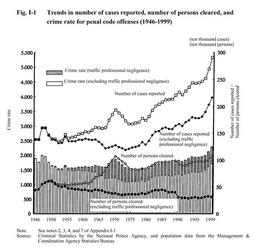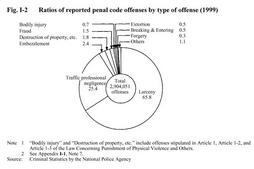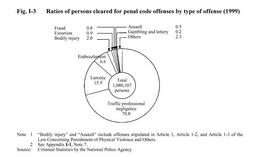| Previous Next Index Image Index Year Selection | |
|
|
The principal data concerning penal code offenses in 1999 are as follows:
Principal data for 1999 (penal code offenses) (year-on-year change) [1] Number of cases reported 2,904,051 (+ 213,784) Excluding traffic professional negligence 2,165,626 (+132,080) [2] Number of cases cleared 1,469,709 (+40,706) Excluding traffic professional negligence 731,284 (?40,998) [3] Number of persons cleared 1,080,107 (+73,303) Excluding traffic professional negligence 315,355 (?8,908) [4] Crime rate 2,292 (+165) Excluding traffic professional negligence 1,709 (+101) [5] Clearance rate 50.6% (?2.5 points) Excluding traffic professional negligence 33.8% (?4.2 points) (Source: Criminal Statistics by the National Police Agency Fig. I-1 shows trends in the number of cases reported, the number of persons cleared, and the crime rate(=the number of cases reported per 100,000 capita of population)with respect to penal code offenses excluding traffic professional negligence in Japan since 1946 (see Appendix I-1 ). The number of penal code offenses reported fell temporarily after peaking in 1970 (mainly due to an increase in traffic professional negligence). However, the number has increased more or less consistently since 1975,recording a new postwar high of 2,904,051 in 1999 (7.9% more than in 1998). Fig. I-2 shows the number of penal code offenses reported in 1999 by type of offense. The most common offense was larceny, followed by traffic professional negligence, embezzlement(including embezzlement of lost property), destruction of property, etc. , fraud, bodily injury, and extortion, in that order(see Appendix I-2 ). The number of persons cleared for penal code offenses decreased after peaking in 1970, but then returned to an increasing trend between 1980 and 1988. After decreasing slightly every year from 1989 to 1991, the number has once again been in a generally increasing trend since 1992. In 1999,it increased by 73,303 (7.3%)from the previous year, reaching a new postwar high. The number of persons cleared for penal code offenses excluding traffic professional negligence has remained at around 300,000 since 1989,and despite in a gradually increasing trend since 1996, fell by 8,908 (2.7%) compared to the previous year in 1999. Fig. I-1 Trends in number of cases reported, number of persons cleared, and crime rate for penal code offenses (1946-1999) Fig. I-2 Ratios of reported penal code offenses by type of offense (1999) Fig. I-3 shows the number of persons cleared for penal code offenses in 1999 by type of offense. The most common offense was traffic professional negligence, followed by larceny, embezzlement(including embezzlement of lost property), bodily injury, extortion, and fraud, in that order(see Appendix I-2 ).As for the gender of persons cleared for penal code offenses excluding traffic professional negligence in 1999, 250,433 were males and 64,922 females. Viewed in proportion to the general population aged 14 or over, there were 471.6 males and 115.4 females per 100,000 capita of population (see Part 4, Chapter 4, Section 1 ). Fig. I-3 Ratios of persons cleared for penal code offenses by type of offense (1999) The crime rate for penal code offenses was in a declining trend after peaking at 2,004 in 1948. It then started to rise again from the mid-1960's, with an increase in traffic professional negligence offenses. From 1971 it again turned downwards, reaching a low of1,493 in 1977. Since then it has been in an increasing trend, rising by 165 to 2,292 in 1999, registering a new postwar high for the second year running. The crime rate for penal code offenses excluding traffic professional negligence, meanwhile, was in a continuing decline after peaking at 2,000 in 1948, and reached a record low of 1,091 in 1973. But it has risen more or less consistently since then, increasing by 101 from the previous year to reach 1,709 in 1999.The clearance rate for penal code offenses has been in a declining trend in recent years. In 1999 it was 50.6%, 2.5 points lower than in the previous year. The clearance rate for penal code offenses excluding traffic professional negligence, meanwhile, was 33.8% in 1999, falling 4.2 points from the previous year to a new postwar low. By type of offense, the clearance rate in 1999 was 96.4% for homicide (down 1.3 points from the previous year), 66.4% for robbery (down9.9points), 84.4% for arson (down3.0points), 73.7% for rape (down14.5points), and 29.4% for larceny (down 4.0 points) (see Appendix I-3 ). |


